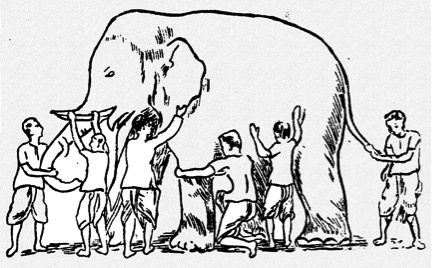Have you heard the old parable from India about the eight blind men and an elephant? Each is in contact with one part of the beast and reports what he senses: the one who stumbled against the elephant’s side says “it’s a wall,” the one in contact with the tusk says “it’s a spear,” the trunk – “a snake,” the knee – “a tree.” Each interprets reality from where he stands.

As with all parables, this one isn’t really about blind men, nor is it about elephants… it’s about all of us – that we draw our conclusions from what we see, from where we stand, and what we know… and as we’re able to take different vantage points we may come to see things differently.
So what does this elephant story have to do with leadership? To answer this question, we’ll explore the notion of the ‘shared picture’ from three angles: what is the shared picture; how it helps you personally as a leader and how it helps organizations be more effective.
As consultants, we’re often asked: how do we enhance morale, increase collaboration, or become more customer focused? In typical consultant fashion we say, well show me your watch and I’ll tell you what time it is. We do this by answering the question with a question: what do folks in different parts of this place have to say about the challenge and why it is so? They’ll offer their perspectives and theories and often ask us to walk the halls and ask around some more. As we listen to different levels, functions and roles, interesting patterns often emerge. When folks come together to discuss the patterns, they begin to see different parts of the elephant. This discussion and summary forms a new ‘shared picture,’ creating the basis for collective action that actually wasn’t present before.
As a leader, the shared picture helps you personally in multiple ways. Initially it allows you to understand your system better, in a more nuanced way. It allows you to create plans that matter to your people and that they’re likely to support since they were consulted. Further, as you evaluate the effectiveness of any changes, you can link back to the shared picture to communicate progress and further reinforce how it was, how it is now, and how you foresee things going forward. Lastly, you can use the process of getting to a shared picture as a leadership strategy for increasing engagement and information flow, connecting you more to your extended team and them to each other.
Organizationally, the shared picture provides a north star to focus people’s attention on areas that matter bringing some cohesion to different and disparate parts – think vision or future-state, but more tactical. With the ever-increasing pace of change, focus provided by the shared picture also creates a sense of stability and common purpose. All of these serve to inspire trust in leadership, that there is a plan, that important things do get addressed and that tomorrow will be better than today. All are elements for enhancing morale.
Let’s face it, you’re busy and don’t have lots of time to launch new things. That’s why we look for the small shifts in behavior that can ripple out, making big changes. This principle of the shared picture is one of those small, simple shifts. You can apply it to a 1-1 conversation, in a team meeting, or an organizational strategy process.
As a next step, consider printing out and posting the elephant graphic above in your office. Allow it to remind you about the notion of the whole and the parts and the shared picture. Start to integrate this into your way of thinking and you may just start to see remarkable results.


